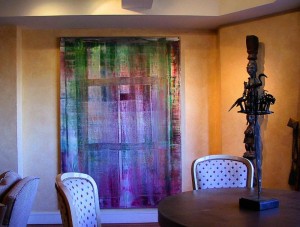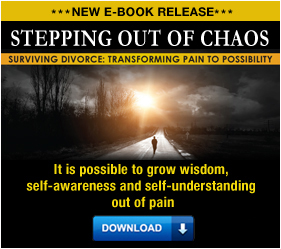Guest post by Gail Green.
The marriage of Divorce and Art is the happy confluence of positive reinvention. Having been through a challenging time, you are now ready to settle into a calmer, happier situation. In effect, the home’s visual setting provides the divorcee with a surrounding air of serenity and peace, where order and balance reign.
While the home is furnished with harmony in command, its close cousins are the paintings, sculptures, objets d’art that accompany each surface and space. The selection and appreciation of artwork is a highly personalized task. Paintings reach far into the unconscious stirrings of the soul and can, therefore, have a particularly strong pull on its owner. The owner may relate to the colors, forms, images, themes or shape. Whichever part, or whole, one relates to in a work of art, one reaps reams of personal stirrings and stories.
Art may be collected for a variety of reasons. For those who see it as an investment, it offers great value as well as inherent beauty. In these cases, the value usually increases over time with an usually high financial commitment. In addition, there may be a certain level of status attached to the possession of well-known artists’ works. Whatever the impetus, the choice of art is an individual and personal exercise, one that should give great happiness and fulfillment to it’s owner, no matter what the price. Now, no longer encumbered by another’s aesthetics, your selections are truly personal. The divorcee can redesign their lives with their own taste and style, with art being a keystone to that emergence.
For most of us, art is an emotional pull. Perhaps, a certain piece comes with fond memories from which is now gleamed a sense of hope and optimism. As Jennifer Safian, a divorce mediator and art collector, notes, “each piece of art, whether it be something that was bought for a special occasion, or during a wonderful vacation, or for a particular work by an artist, brings back a series of memories. In general, divorced people prefer the more peaceful soothing effects that art has.” For these, indeed, art may provide a therapeutic antidote.
Brenda McMahon’s softly molded ceramics create this meditative quality. Many of her pieces are not only aesthetic, they are emotionally restorative. Here, blended colors swirl and move to the beat of earthen jars, simultaneously providing a sense of tranquility and calm. As Brenda notes, “my organic fired ceramic artwork has soft colors and a smooth surface; it speak a sense of timelessness to the observer. Art for the divorcee should be non-judgmental; the abstract colors of nature are strong pulls for people in transition.” As an artist, McMahon believes that the creative process requires tapping into the “zone’ of non-thought, which is guided by artistry and intellect.” She believes that “the germination of art is energy, resulting in art as a sharing and transfer of energy. Art is a gift that keeps giving.”
In selecting art, color and shape are very important. Tapping into the subconsciousness means understanding what colors poignantly say. The natural tones of soft blues, greens, beiges, and golds are, for instance, soothing. Bolder, starker colors such as blacks, pure whites, primary colors (unless they recreate especially happy experiences) are not usually soft and calming. It is best to select rusts, muted browns, pastels, and even light grays. McMahon goes on to suggest that “nature tends to relax and rejuvenate us, so art that reflects such would be a great choice for someone in transition. Selecting pieces whose colors reflect nature are an effective counterbalance to the uncertainty one faces at this time. Art should not be highly provocative and controversial, but should speak to the soul’s serenity.
“Art needs to be uplifting, not anxiety provoking,” Brenda notes. Themes need to be soothing, making you feel good about yourself and suggestive of a happy future. Pieces should be pleasing and kinesthetically harmonious. In effect, art provides fellowship, as these individual pieces become your lifelong friends. Images portraying pastoral landscapes, ocean vistas, animals at play and abstracts are good choices. In terms of form, art can take any shape: painting, sculpture, bas-reliefs, etc. Though softly rounded shapes are best, like a Jean Arp sculpture, restorative themes are more important than any particular shape or form.
 Divorce design is positive reinvention. It is a turning towards the future, albeit different, yet hopeful. As one leaves behind the turmoil surrounding divorce, one can use this period to institute changes for the better. From “We” to Me,’ the divorced person now lives in an environment reflective of their individual personalities. It is a fresh start! Creating a cheerful home through the implementation of pleasing art is highly restorative. As Nina Baldwin says, “Art touches the soul…art is communication…it reaches out from the canvas and passes through the eyes of the viewer right into his heart where it can leave an imprint of beauty that can make the spirit sing.”
Divorce design is positive reinvention. It is a turning towards the future, albeit different, yet hopeful. As one leaves behind the turmoil surrounding divorce, one can use this period to institute changes for the better. From “We” to Me,’ the divorced person now lives in an environment reflective of their individual personalities. It is a fresh start! Creating a cheerful home through the implementation of pleasing art is highly restorative. As Nina Baldwin says, “Art touches the soul…art is communication…it reaches out from the canvas and passes through the eyes of the viewer right into his heart where it can leave an imprint of beauty that can make the spirit sing.”
[divider style=”dashed”]
 Gail Green Interiors is an interior design, architecture, and decorating firm specializing in upscale residential and commercial projects throughout the country. Attention to detail, timeless elegance, classical simplicity, and quality workmanship are our hallmarks.
Gail Green Interiors is an interior design, architecture, and decorating firm specializing in upscale residential and commercial projects throughout the country. Attention to detail, timeless elegance, classical simplicity, and quality workmanship are our hallmarks.




